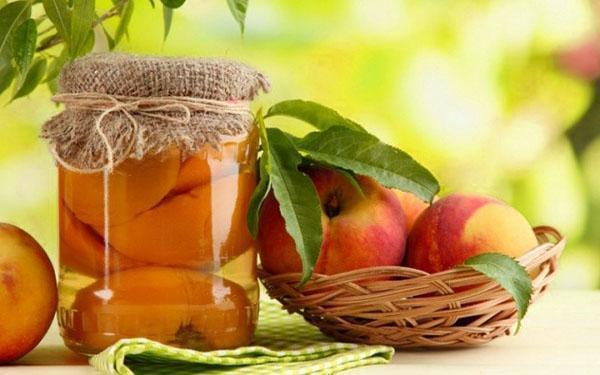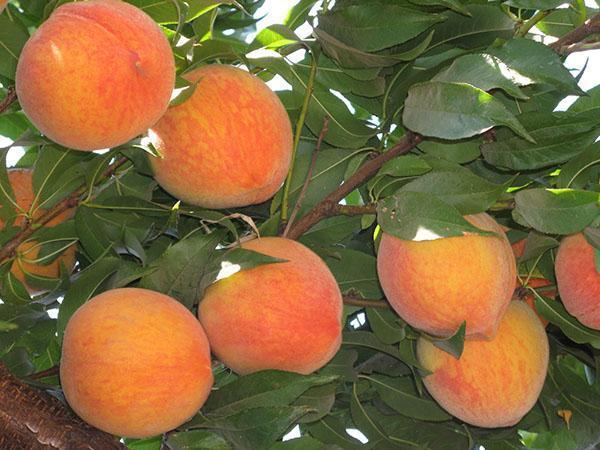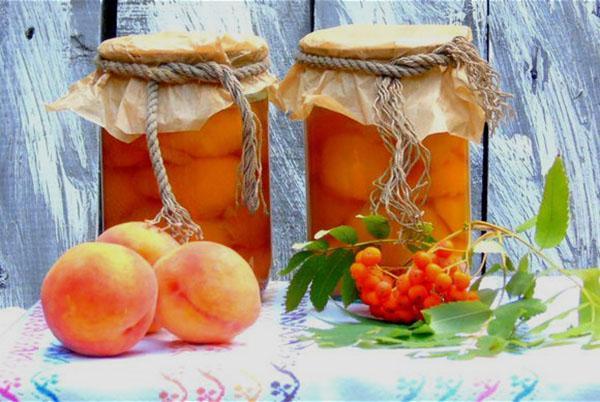Harvesting peaches in their own juice for the winter
 The easily digestible peach pulp is juicy, tasty, aromatic and requires to be eaten at any time of the year. Peaches in their own juice for the winter are just what a person needs during a lack of vitamins. In the last century, the miracle fruit was a wonder, it was a delicacy and was happily consumed only fresh. Peaches are now available in any type and variety. Large nectarines are very popular due to their sweet taste. The fruit of the peach tree is perishable, after lying on the table for a day, it withers, changes in color, and with a slight impact, this place darkens. If you have a large number of such fruits, and you do not have time to eat them, you should definitely resort to the preservation procedure and, preferably, in your juice. How to cook peaches in your own juice is described below.
The easily digestible peach pulp is juicy, tasty, aromatic and requires to be eaten at any time of the year. Peaches in their own juice for the winter are just what a person needs during a lack of vitamins. In the last century, the miracle fruit was a wonder, it was a delicacy and was happily consumed only fresh. Peaches are now available in any type and variety. Large nectarines are very popular due to their sweet taste. The fruit of the peach tree is perishable, after lying on the table for a day, it withers, changes in color, and with a slight impact, this place darkens. If you have a large number of such fruits, and you do not have time to eat them, you should definitely resort to the preservation procedure and, preferably, in your juice. How to cook peaches in your own juice is described below.
Read also the article in the topic: peach jam recipes!
A couple of lines about the importance of the peach

 The fruits of the peach tree are divided into 2 types: with a velvety skin and glossy. The provided types are divided into two subspecies: with an easily removable bone and difficult to separate. Due to these characteristics, each has its own special taste fresh and processed. Ripe peaches can be tasted as early as July and end up enjoying this gift of nature in October. To prolong the pleasure, the fruit in question can be processed into compotes, juices, jams, preserves, and even canned peaches in their own juice, the recipe for which is provided with a photo and a step-by-step description.
The fruits of the peach tree are divided into 2 types: with a velvety skin and glossy. The provided types are divided into two subspecies: with an easily removable bone and difficult to separate. Due to these characteristics, each has its own special taste fresh and processed. Ripe peaches can be tasted as early as July and end up enjoying this gift of nature in October. To prolong the pleasure, the fruit in question can be processed into compotes, juices, jams, preserves, and even canned peaches in their own juice, the recipe for which is provided with a photo and a step-by-step description.
A 1 liter jar holds about 0.5 kg of medium peaches.
Peaches in their own juice with sterilization
Ingredients: peaches - 6 pcs, water (not boiled) - 4 tbsp. spoons, sugar - 1 tbsp. the spoon.
Cooking steps:
- Wash the peaches and remove the peels.

- Divide in two and remove the bone.
- Push tightly into a sterilized jar in layers with sugar.

- Add water and place in a pot of water to sterilize. Sterilize for 25 minutes.

- Take out the cans, tighten the lid, turn over and wrap with a dense cloth for a day.

- The provisions for the table are ready.
Peaches in their own juice without sterilization
Ingredients: peaches - 1.5 kg, water (not boiled) - 1.5 liters, sugar - 200 g, citric acid - 1 tsp.
Cooking steps:
- Pour boiling water over the fruit and remove the skin, remove the seeds.

- Fill the jar with the resulting pieces to the neck. Spread out carefully so that the spherical fruits do not lose their appetizing shape.
- Boil water and pour it into a glass container, cover and let stand for about half an hour.

- Drain the aromatic water back into the saucepan, add sugar and citric acid. Boil this drug again until the sugar is completely dissolved.
- Pour the ready-made syrup over the jars with the contents and roll up the lids. Turn hot food over and put in a warm blanket until cool.

- After cooling down, return them to their normal position and put them in the pantry.
Peaches in their own juice: a recipe without water
Components for three pieces of 1.5 l jars: peach - about 4 kg, sugar - 1.5 kg.
Cooking steps:
- The washed peaches are cored and cut into pieces.

- The following components are laid out in layers in a jar: a layer of sugar, a layer of peaches.

- Place the cans in a pot of water for sterilization so that the hangers of the cans are half submerged in water. Sterilized for 40 minutes, during the heating process, juice begins to stand out from the fruit and fill the container with it. The peaches soften, leaving space for a couple more fruits.

- After sterilization, the jars are carefully removed and sealed tightly with a lid, turned over and wrapped in a warm cloth.

- The provisions are ready.
Peaches in their own juice without sugar
 Ingredients: juicy peaches or nectarine
Ingredients: juicy peaches or nectarine
Cooking steps:
- Wash sorted fresh, not spoiled peaches thoroughly in water, remove seeds.

- Put the halves in a glass container to the brim, sterilized in advance.

- Boil water and pour it over peaches.
- Prepare for the sterilization procedure: put a towel or a loose cloth on the bottom in an enamel pan, put jars of fruit and pour warm water up to the jar's shoulders. Turn on the fire and bring the liquid to a boil, and then the sterilization time depends on the juiciness of the fruits and the rate at which juice is released from them, due to the high temperature. This usually takes 15-20 minutes.

- The sterilized provisions are rolled up with tin lids, the container is turned over and wrapped in a blanket.
- The sweetness is ready!
Prescription peaches without sugar can be consumed even by diabetics.
 Peaches in their own juice, prepared for the winter, can be eaten whole without anything, and also used as an ingredient in other dishes, for example, pies, jellies, casseroles, jelly. Other fruits can be added to the canning to vary the standard peach flavor. A sweet peach will give a sophisticated flavor when combined with a plum, the canning steps of which will only be supplemented by processing the plum. It will also be necessary to remove the peel from it and remove the seeds, and then the recipe for canning in its own juice will be the same, only the peach and plum will be located in the jar. Slices can perfectly take the place of plums orange, lemon slices, pineapple pieces, apple or pear pieces, raspberries, strawberries.
Peaches in their own juice, prepared for the winter, can be eaten whole without anything, and also used as an ingredient in other dishes, for example, pies, jellies, casseroles, jelly. Other fruits can be added to the canning to vary the standard peach flavor. A sweet peach will give a sophisticated flavor when combined with a plum, the canning steps of which will only be supplemented by processing the plum. It will also be necessary to remove the peel from it and remove the seeds, and then the recipe for canning in its own juice will be the same, only the peach and plum will be located in the jar. Slices can perfectly take the place of plums orange, lemon slices, pineapple pieces, apple or pear pieces, raspberries, strawberries.
Read also about:pitted cherry jam for the winter thick!
Hello.
I was interested in the recipe "Peaches IN OWN JUICE WITHOUT SUGAR".
The recipe lists the ingredients: "juicy peaches or nectarine" ... (and nothing else, just the fruits).
Explain, please, what point number 3 means: "Boil water and pour it into peaches" ?? : ((((Is this for blanching-sterilization of fruits? That is, pour boiling water over the peaches, and then DRAIN it?
No matter how tightly you put the fruits in the jar, the air will remain. When sterilized, the fruits will settle and there will be a void in the jar. This is a recipe for diabetics. peach with peel, cut into slices. Boil water and pour over peaches, sterilize. Water will help keep the peach chunks in shape. The jar contains very little water and it does not change the taste of the fruit.